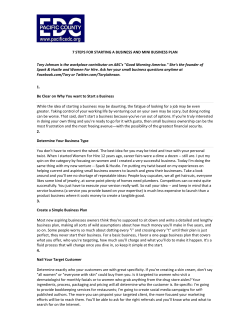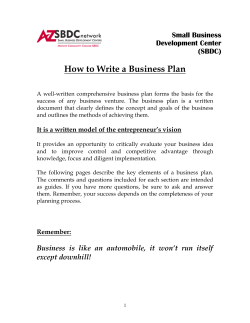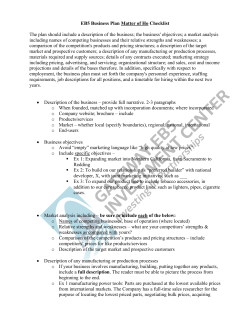
y Workshop T
Ohio Energy Workshop T Advanced Energy Procurement: Beyond the Fixed Rate & Key Issues to Understand When Comparing Electricity Quotes Tuesday, February 18, 2014 3:15 p.m. to 4:30 p.m. Biographical Information Beth M. Polk, Regional Sales Manager (Ohio & Illinois) GDF SUEZ Energy Resources, NA, 720 North St., Independence, OH 44131 216-772-2486 Fax: 888-725-0527 Beth.Polk@gdfsuezna.com Beth has a deep understanding of the Ohio energy market and is well-versed in procurement strategies for large commercial and industrial consumers. Her background includes helping customers align unique business drivers with energy usage patterns to determine appropriate product structures. Beth started her career at AT&T in 1996, and began working as an energy consultant in 2009. She has worked as Regional Sales Manager for GDF SUEZ Energy Resources since 2011 and covers the Ohio and Illinois PJM markets. Beth is a graduate of The University of Akron with a B.A. in Business & Organizational Communication and a minor in Business Administration. David Braun Vice President and Chief Operating Officer Hospital Energy LLC 232 N. Clinton Avenue, Elmhurst, IL 60126 david@hospitalenergy.com Mr. Braun has over two decades of experience in the energy and utility industries, including 16 years in the deregulated electricity and natural gas markets across the United States. He brings to Hospital Energy his expertise in energy product structuring, pricing, energy risk management and operations. Mr. Braun frequently speaks on electricity procurement best practices at various industry forums which have included the Association of Energy Engineers’ World Energy Congress and Globalcon, Manufacturers’ Education Council Energy Management Conferences, and various industry and trade association conferences. Prior to joining the company, Mr. Braun was Regional Vice President at GDF SUEZ Energy Resources and was responsible for retail electricity sales efforts across the Mid-Atlantic and Midwest regions. Prior to that he held management positions in sales, marketing, and operations at Direct Energy, The NewPower Company, Exelon Energy, and Commonwealth Edison. Mr. Braun earned a Bachelor of Science degree in mechanical engineering from Northwestern University in Evanston, Ill., and a Master in Business Administration from the University of Chicago. Hospital Energy is the leading provider of energy procurement advisory services to healthcare institutions. Through our partnerships with the nation’s leading healthcare group purchasing organizations, Hospital Energy has created an unprecedented aggregation of healthcare energy load that provides our customers a range of procurement options not typically available through other sources. In particular, aggregated load enables Hospital Energy to provide our customers access to wholesale pricing while maintaining retail contract protections. We specialize in aligning healthcare systems with multiple hospital sites around a central procurement strategy. We take the view that energy procurement is primarily a financial transaction and the key to savings is a risk management approach supported by state-of-the-art financial analytics. Advanced Energy Procurement Beyond the Fixed Rate Beth Polk | Independence, OH | 216.772.2486 | Beth.Polk@gdfsuezna.com About GDF SUEZ Energy Resources NA (GSERNA) A member of the GDF SUEZ group - founded in 1822 (190+ yrs) • Global leader in independent power production • Over $117 billion in 2012 revenues • Over 215,000 employees globally; over 20,000,000 customers worldwide • GDF SUEZ ranked 17th “World’s Biggest Company” in Forbes Global 2009; #1 largest utility* • Highest credit rating of leading energy providers in the U.S. A rating by S&P • FORTUNE Magazine Ranked #1 Most Socially Responsible Company in the World, Top 10 Most Accountable Firms, Top 6 Most Admired Energy Companies Globally, 2012** • Ranked #6 on Business Week list of “The World’s Best Companies of 2009”*** http://money.cnn.com/magazines/fortune/mostadmired/2012/best_worst/best4.html * April 2008 Forbes Global 2009 Report • GDF SUEZ Energy Resources serves over 60,000 commercial, industrial, and institutional accounts • Load Served −Total Load > 8,500 MW −14,500 MW of power generation in U.S. −> 500 MW of “green” power generation −650 MW of generation in Ohio ** FORTUNE Magazine, 2008, 2009, 2012 *** Business Week, May 17, 2010 2 Agenda: What goes into the price of Electricity… Electricity Cost Components…. Basic building blocks of energy… Price Risk & Reward Identification… Product Structures… Fixed, Index, Heat Rate Customer Examples and Comparisons…. Question & Answer… 3 PJM: Electricity Cost Components Delivery–type costs: Customers are price - takers: Costs are less manageable Energy: Cost is Manageable Including congestion and line losses 4 PJM: Electricity Cost Components Delivery Costs – Transmission Transmission Cost for transporting power over the interstate transmission grid… -Regulated by FERC under the Network Integrated Transmission Service (NITS) tariff for each transmission owner -Transmission Calculation = NITS price ($/MW-day) * Trans PLC * days in billing cycle • • NITS in AEP: $32,035/MW-year effective July 1st; $0.0061/kWh at 60% Load Factor NITS in ATSI, Dayton & Duke: Not a Competitive Supplier Charge TO FIX OR NOT TO FIX: - Transmission charges are a transparent calculation, therefore we recommend passing it through at cost. Should a customer lower their Transmission PLC then the savings would be passed to them instead of the supplier. 5 PJM: Electricity Cost Components Delivery Costs – Ancillaries Ancillaries - Additional products and services provided by PJM to ensure safe and reliable operation of the regional electricity system - Reliability Must Run (RMR) charges • Coal plant retirements due to age and potential carbon restrictions • Some units will be required to keep operating for reliability until new generation or transmission upgrades can be completed • PJM may announce RMR charges in Ohio due to requested retirement of Coal Generation units • Potential RMR charges are unknown at this time, but is likely to occur soon • Understand how a supplier is handling it - RMR, TECs, Reactive Supply and Voltage Control, and Transmission Owner Scheduling, System Control, & Dispatch are not Competitive Supplier charges in FE Ohio, Duke, or Dayton TO FIX OR NOT TO FIX: - Ancillary charges vary each month. Therefore, suppliers must use a forecasted charge when fixing ancillaries. To avoid premiums, customers can pass through ancillary charges at cost as a line item on their bill. 6 PJM: Electricity Cost Components Delivery Costs – Capacity CAPACITY = PLC Capacity Tag * scaling factors * RPM rate * # of days in month Cost for generation installed… PJM sets capacity rates 3 years in advance through an auction process known as the Reliability Pricing Model (RPM). Rates are effective from June through May. Customer Capacity Cost The PLC Capacity Tag is based on each customer meter’s share of the Peak Load Contribution defined as the five peak hours of the PJM RTO during the preceding summer. Typical CP occurrence: between 4-6 p.m. weekdays from late June through August on very hot, humid days. RPM Clearing Prices in $/MW-Day PY 08/09 PY 09/10 PY 10/11 ATSI PY 11/12 PY 12/13 PY 13/14 PY 14/15 PY 15/16 PY 16/17 $108.89 $20.46 $28.45 $128.17 $294.03 $90.54 $28.45 $128.17 $134.62 $59.37 $28.45 $128.17 $134.62 $59.37 $28.45 $128.17 $134.62 $59.37 AEP $113.22 $104.82 $182.85 $116.23 $16.74 DAY $113.22 $104.82 $182.85 $116.23 $16.74 DEOK You have some control over your PLC tag – 1. Avoid or reduce operations (load) in hours when grid load is expected to peak 2. Run on-site generation during those potential peak hours 3. Demand Response programs 4. Invest in energy efficiency 7 7 7 Capacity: Market in PJM To Fix or Not to Fix? Just like any of the supplier Delivery Costs, Capacity can be Fixed in a price or passed through at cost. • We recommend passing through capacity at cost if customers are enrolled in DR programs and working to control their Peak Load Contribution (PLC) by using less energy during the five peak hours that PJM grid peaks. Otherwise, the savings the customer is working toward will be passed on to the supplier instead of the customer. 8 PJM: Electricity Cost Components Energy Costs Hub Energy Zonal Basis Shape Straddle Imbalance Losses 9 Hourly Pricing - Historic AD Hub Day-Ahead LMPs $/MWh Day Ahead Historical LMPs - AEP Dayton Hub 2008 2009 2010 2011 2012 2013 $ 53.21 $ 32.99 $ 37.57 $ 40.67 $ 31.45 $ 35.52 10 What Moves Power Prices? Correlation Between Natural Gas & Power Historical AEP Dayton Hub Cal 14 vs. NYMEX HH Cal 14 chart Correlation averaging approximately 94% 94.8% Correlation 1 11 1 Considerations: Historic & Future Pricing: Power 12 Product Structure and Pricing Options Tariffs: Not hedgeable Risk premiums or risk transfer (contract language) Hedgeable Any or all of the adders can be combined into or excluded from the energy pricing structure – know what you’re buying! •Include or pass-through adders: • Capacity • Transmission • Ancillaries • Line Losses (T&D) • Taxes • Energy Structure • Fixed • Index + Adder • Real-Time • Day-Ahead • Fixed Blocks • Heat Rate 13 Product Structure and Pricing Options Risk/Reward Spectrum • How do you know what product to select? Very risk tolerant: • Index product with full pass thru of delivery components Little risk tolerance: • Fixed product More risk tolerant: • Block and index • Fixed with cap and trans pass thru 14 Product Structure and Pricing Options Fixed Fixed price: Fixed price can include or pass through any or all components – capacity, transmission, ancillaries, T&D losses -FIXED RTC (Round the clock) -FIXED ON PEAK -FIXED OFF PEAK PROS: -Price certainty and simplicity CONS: -You’re betting that today is the best day to contract (less than 5% chance). -Little Flexibility -Premiums for load shaping, load following, and forward risk Realize that an “All In” price does not mean that components are fixed! • Suppliers should clearly list on quote what is included and fixed in rate, and what is floating. For example, capacity may be included but subject to change when new PLC tags are released. Make sure you know. Otherwise, you will not have an apples to apples comparison. 15 Product Structure and Pricing Options INDEX Index Structure: − Index to either Day Ahead or Real Time LMP at Zone or Hub − Adder can include or pass through any or all of the following capacity, transmission, ancillaries, T&D losses − Option to fix (hedge) blocks PROS: -No forward risk premiums -No load shaping and load following risk premiums -Ability to take advantage of market dips fix as much/little of load at any time CONS: -You’re betting that today is the best day to contract (less than 5% chance). -Little Flexibility -Premiums for load shaping, load following, and forward risk 16 Product Structure and Pricing Options BLOCK & INDEX Index Pricing - Hedging with Fixed Price Blocks Energy cost is variable - Changes hourly - Indexed to zonal price posted by PJM - Choice of day ahead prices or real time Blocks - Fix a portion of the load - Variety of options: Peak, off peak, min of one month - Build a portfolio of hedges and dollar cost average – like your 401k Benefits - Index portion won’t pay any forward risk premium - Avoid load shaping and load following risk premiums (lower cost) - Not making the bet that “today” is the best day to buy power - Take advantage of declining power prices Risks - Market runs up before you hedge – mitigate by having a plan and sticking to it 17 Product Structure and Pricing Options BLOCK & INDEX Energy Price Risks: Shaping Supply • You can build a portfolio of hedges to manage your entire load profile • Strike hedges opportunistically based on market conditions over time 18,000 16,000 14,000 12,000 KW 10,000 8,000 6,000 4,000 2,000 Block 3: 5 MW Peak @ $38/MWH Block 2: 3 MW RTC @ $30/MWH Block 1: 5 MW RTC @ $31/MWH 0 Hour Ending 18 18 Product Structure and Pricing Options HEAT RATE Product Design What is Heat Rate? • Electrical service at a price based on a highly visible natural gas index • Technically, heat rate is used to describe the amount of fuel required to generate a kWh of electricity • Heat Rate and Retail Adder are fixed at the time contract is signed • The heat rate used in the energy price formula will be market-based and not tied specifically to a generator • Natural Gas price is settled monthly • Customer may have opportunity to lock in the gas price in advance of the gas settlement date • Customer may lock in a Fixed Price at anytime in the future • Customer can calculate the Energy Price before the start of each month no hourly volatility during the delivery month Energy Price $/MWh Customer Benefit Heat Rate Product 100 80 60 Sample Energy Price = 8.5 HR * NYMEX + $7 40 20 0 5 5.5 6 6.5 7 7.5 8 8.5 NYMEX Price $/mmbtu (1) Market-based heat rate 19 Product Structure and Pricing Options HEAT RATE What is it? as an Efficiency Factor, Heat Rate is a factor that measures how efficiently a generator converts thermal energy into electricity. It is the amount of fuel energy (such as natural gas) required by a power plant to produce one kilowatt-hour of electrical output. Heat Rate, as a Retail Electricity Product, is a product that offers consumers an opportunity to link the price of electricity to the price of natural gas. In retail markets, Heat Rate products are generally based off a “Market Implied” Heat Rate, derived from dividing the forward power price by the forward gas price, as shown below. Rather than opting for a Fixed Price contract, customers on a Heat Rate pay a price for electricity that varies based on the settle price of the agreed upon natural gas price index such as the New York Mercantile Exchange (NYMEX). 20 HEAT RATE: How Does It Work? The Electricity Price for a Heat Rate product is calculated on a calendar month; by multiplying a Heat Rate by a Gas Index, then adding the Retail Adder, as shown below. The Gas Index varies monthly, based on the settlement of that index. The Electricity Price component is calculated as the Heat Rate multiplied by the monthly settled Gas Index price. Example: Customer ABC is on a Heat Rate product, with a HR of 9 and a Retail Adder of $8.50. The Gas Index is NYMEX. In order to calculate the electricity price for one month, (September 2012), take the NYMEX settle price for that month, $2.634, and perform the following calculation: Electricity Price = (9 x $2.634) + $8.50 = $32.21/MWh or $0.03221/KWh 21 Example of Customer on Heat Rate CUSTOMER ON HEAT RATE IN 2012 January‐12 February‐12 March‐12 April‐12 May‐12 June‐12 July‐12 August‐12 September‐12 October‐12 November‐12 December‐12 AVERAGE PRICE NYMEX NG SETTLE PRICE $3.08 $2.68 $2.45 $2.19 $2.01 $2.43 $2.77 $3.01 $2.63 $3.02 $3.47 $3.70 X HEAT RATE FACTOR + 9 9 9 9 9 9 9 9 9 9 9 9 ALL‐IN Retail Adder ELECTRICITY /MWh = PRICE/MWh $8.50 $36.22 $8.50 $32.62 $8.50 $30.55 $8.50 $28.21 $8.50 $26.59 $8.50 $30.37 $8.50 $33.43 $8.50 $35.59 $8.50 $32.17 $8.50 $35.68 $8.50 $39.73 $8.50 $41.76 $33.58 ALL‐IN ELECTRICITY PRICE/kWh $0.03622 $0.03262 $0.03055 $0.02821 $0.02659 $0.03037 $0.03343 $0.03559 $0.03217 $0.03568 $0.03973 $0.04176 $0.03358 Would you have liked to pay $0.03348/kWh?? 22 HEAT RATE: Historic Chart of Heat Rate Factors at AD HUB 23 Is Heat Rate Right for Me? A company’s perception of whether or not Heat Rate products are “good” for the company depends on the company’s view of the gas market and its tolerance for risk. Companies - forecasting a downward trend in natural gas prices may choose a Heat Rate product, rather than a Fixed Price, so they can take advantage of future declines in market prices - with resources dedicated to monitoring the gas market may also prefer a Heat Rate product. For example, if a company already used to hedging gas, they are likely more comfortable with a Heat Rate product. In addition, they will only need to watch the commodity of gas instead of both electricity and gas. - with an end-product directly related to natural gas,(e.g. refineries), may prefer a Heat Rate product A longer time horizon is beneficial to customer when buying a heat rate, i.e. deal starting 12 months from today gives the customer time for gas to fall 24 Hospital Energy Hospital Energy is the nation’s leading energy procurement organization for healthcare with more than $1 billion in contracts under management. Our unique approach includes: • Aggregation of national healthcare spend to drive value in all energy markets • Establishment of centralized, finance‐driven Analytical market procurement for health systems • Alignment of finance, supply chain and facilities staff around a single market strategy across all campuses Pick the Right Supply Partner The optimum supply partner should provide: • robust risk management and hedge capability • transparent, protective contract terms and billing practices • best‐in‐class pricing • financial strength to ensure contract fulfillment • excellent customer support and service Potential Product Structures • Fixed all‐in: • Fixed price for term, which includes all costs: Energy, shaping/load following premiums, capacity, ancillary services, losses, and renewable portfolio standard • Simplest product design, but highest ultimate cost • Least flexible – makes a bet that contracting day is best day to buy power • Doesn’t necessarily eliminate risks which enter through contract language • Levels capacity costs over term which causes cash flow issues • Fixed with capacity pass through • Eliminates cash flow issues caused by known capacity fluctuations • Fixed Energy‐only • Eliminates risk premiums paid to supplier on non‐energy components • Percentage Fixed • Allows for multiple opportunities to set fix price which takes advantage of dollar cost averaging effect • Index pricing with Fixed Price Blocks • Stripped down contracting achieves wholesale cost structure • Allows most flexibility in fixing prices – generates lowest ultimate cost of supply • Eliminates risk premiums paid to supplier for non‐energy components & load following Wholesale Electricity Pricing Heat Rate Electricity Price Fuel Price Example 1: Heat Rate Customer Gas Locks for Heat Rate • Term: February 2012 to January 2014 • Heat Rate Multiplier at 10.85 • This customer layered in gas contracts over the term of the contract to manage their electricity price risk • Initially hedged gas worth 25% for full term; then layered in 25% for first year and 50% for first 6 months; Later added more hedges Feb‐12 Mar‐12 Apr‐12 May‐12 Jun‐12 Jul‐12 Aug‐12 Sep‐12 Oct‐12 Nov‐12 Dec‐12 Jan‐13 Feb‐13 Mar‐13 Apr‐13 May‐13 Jun‐13 Jul‐13 Aug‐13 Sep‐13 Total NYMEX LDS $2.678 $2.446 $2.191 $2.036 $2.429 $2.774 $3.010 $2.634 $3.023 $3.471 $3.696 $3.354 $3.226 $3.427 $3.976 $4.152 $4.148 $3.707 $3.459 3.567 Monthly Volume 1,748.23 2,086.55 1,801.99 2,260.40 2,619.13 3,049.48 2,874.03 2,384.52 2,427.44 1,873.48 2,008.99 1,929.01 1,687.49 2,071.95 1,832.56 2,260.04 2,662.67 3,002.89 2,864.30 2,384.52 Rate $37.107 $37.107 $37.107 $37.107 $37.107 $37.107 $37.107 $37.107 $37.107 $37.107 $37.107 $37.107 $37.107 $37.107 $37.107 $37.107 $37.107 $37.107 $37.107 $37.107 % 25.0% 25.0% 25.0% 25.0% 25.0% 25.0% 25.0% 25.0% 25.0% 25.0% 25.0% 25.0% 25.0% 25.0% 25.0% 25.0% 25.0% 25.0% 25.0% 25.0% Price Locks Rate % $33.472 25.0% $33.472 25.0% $33.472 25.0% $33.472 25.0% $33.472 25.0% $33.472 25.0% $33.472 25.0% $33.472 25.0% $33.472 25.0% $33.472 25.0% $33.472 25.0% $33.472 25.0% $35.371 25.0% $35.371 25.0% $35.371 25.0% $ 43.67 25.0% $ 43.67 25.0% $ 43.67 25.0% $38.518 25.0% $ 43.67 25.0% Rate $30.923 $30.923 $30.923 $30.923 $30.923 $30.923 $35.046 $35.046 $35.046 $35.046 $35.046 $35.046 $35.046 $35.046 $35.046 % 50.0% 50.0% 50.0% 50.0% 50.0% 50.0% 50.0% 50.0% 50.0% 50.0% 50.0% 50.0% 50.0% 50.0% 50.0% $40.145 $ 43.67 50.0% 25.0% Unhedged % Initial Total 0.0% 0.0% 0.0% 0.0% 0.0% 0.0% 0.0% 0.0% 0.0% 0.0% 0.0% 0.0% 50.0% 0.0% 50.0% 0.0% 50.0% 0.0% 50.0% 0.0% 50.0% 0.0% 50.0% 0.0% 75.0% 0.0% 75.0% 0.0% 75.0% 0.0% 50.0% 50.0% 50.0% 50.0% 50.0% 0.0% 50.0% 25.0% 75.0% 50.0% Electric Budget Initial All Hedges Hedges Montly Price $57,877 $57,877 $33.11 $69,077 $69,077 $33.11 $59,657 $59,657 $33.11 $74,833 $74,833 $33.11 $86,709 $86,709 $33.11 $100,956 $100,956 $33.11 $97,642 $101,073 $35.17 $76,148 $83,858 $35.17 $82,641 $85,367 $35.17 $68,335 $65,886 $35.17 $75,730 $70,651 $35.17 $69,136 $67,839 $35.17 $59,954 $60,146 $35.64 $77,002 $73,849 $35.64 $76,292 $65,317 $35.64 $96,546 $96,546 $42.72 $113,688 $113,688 $42.70 $121,031 $120,917 $40.27 $80,320 $112,298 $39.21 $91,335 $94,296 $39.55 $1,543,576 $1,566,544 Savings via Heat Rate Example Program 2011 Rate (Suppler A) Savings v. 2011 Savings v. 12‐ Rate 13 Fixed Savings v. Index $/kWh $0.06300 Cost $2,737,045 2012‐13 (Supplier B) Fixed Rate Offer $0.04903 $ 2,130,116 2012‐13 LMP Index $0.03948 $ 1,715,215 $1,021,830 $ 414,901 Actual Rate with Supplier B HR and gas locks: $0.03716 $ 1,614,422 $1,122,623 $ 515,694 $ 100,793 $606,929 • Energy markets fell significantly from 2010 (when 2011 rate was set) to 2012 but is up in 2013 • The Supplier B ‘12‐13 fixed offer represents a significant amount of that move • The HE/Supplier B heat rate contract with gas locks beat the pure index because it locked in the market Heat Rate and then natural gas fell • The electricity index didn’t fall as much because the market heat rate increased during the term Example 2: Fixed Energy Only Contract Summary of Current Electricity Contract • Fixed price for energy only • • • • • • Fixed price: $34.81/MWH ($0.03481/kWh) September 1, 2012 to August 31, 2014 (ends at Sept. meter read) Load following product Priced at Northern IL Hub Full requirements, no consumption bandwidths Material Adverse Change clause – Supplier could collect addition costs if usage patterns change substantially (>25%+/‐) • Pass through of regulated non‐energy components: • • • • • Capacity Transmission (NITS) Ancillaries including IL RPS Line losses Congestion costs • This product fixes what you can control and avoids paying risk premiums for regulated costs you can’t control 32 Price Performance versus Index • Historic analysis of index v. fixed • 100% index pricing would have saved 3.7% Month Actual KWH Sep-12 2,662,800 Oct-12 2,544,496 Nov-12 2,447,731 Dec-12 2,673,846 Jan-13 2,863,605 Feb-13 2,625,241 Mar-13 2,764,301 Apr-13 2,519,253 May-13 2,648,280 Jun-13 2,712,461 Jul-13 3,022,373 Aug-13 2,984,366 Grand Total 34,613,205 33 Index Average $ 32.54 $ 26.49 $ 31.56 $ 28.79 $ 29.46 $ 30.19 $ 34.58 $ 36.21 $ 34.23 $ 31.91 $ 41.08 $ 30.85 $ 30.40 Cost or (savings) $ 2,683 $ 18,568 $ 5,100 $ 12,869 $ 11,861 $ 9,096 $ (2,763) $ (6,713) $ (1,841) $ 4,810 $ (21,844) $ 8,298 $ 40,124 3.7% Volumetric Deviation Analysis • Current contract has monthly volumetric protection which is a premium product • Actual deviations averaged only 3.1% • Deviation range of ‐7.3% to +9.6% • Option to change to 10% bandwidth, which saves $0.10, but annual savings of $3,000 is probably not worth the additional risk Month Actual Meter Vol Contract Vol Vol. Diff Sep-12 2,454,872 2,240,690 214,182 Oct-12 2,345,806 2,200,520 145,286 Nov-12 2,256,597 2,213,660 42,937 Dec-12 2,465,056 2,658,310 (193,254) Jan-13 2,639,997 2,743,280 (103,283) Feb-13 2,420,246 2,311,790 108,456 Mar-13 2,548,448 2,411,010 137,438 Apr-13 2,322,534 2,190,460 132,074 May-13 2,441,486 2,293,850 147,636 Jun-13 2,500,655 2,409,310 91,345 Jul-13 2,786,368 2,724,340 62,028 Aug-13 2,751,328 2,637,690 113,638 Grand Total 29,933,394 29,034,910 898,484 9.6% 6.6% 1.9% -7.3% -3.8% 4.7% 5.7% 6.0% 6.4% 3.8% 2.3% 4.3% 3.1% MAC Premium: 0.1 MAC Cost: $ 2,993 34 Budget Analysis - 100% Index Rate Actual customer example – Jan 28, ‘14 June 2014 – May 2016 35 Best Case Expected Case Worst Case $30.28 $33.15 $37.54 ($423,885) $4,905,587 +$650,182 Budget Analysis - 50% Fixed Rate Hedge June 2014 – May 2016 Actual customer example – Jan 28, ‘14 36 Best Case Expected Case Worst Case $32.18 $33.55 $35.86 ($202,927) $4,965,601 +$341,648 Energy Budget Risk Analysis Example 24 Month Scenarios Actual customer example – Jan 28, ‘14 100% Fixed Rate 50% Fixed Rate 100% Index (Unhedged) Worst Case $34.01 $35.86 $37.54 Expected Case $34.01 $33.55 $33.15 Best Case $34.01 $32.18 $30.28 $5,033,231 $4,965,601 $4,905,587 $0 $346,248 $682,016 Expected Energy Cost Savings Opportunity/Risk Budget Analysis - 100% Index Rate Actual customer example – Jan 28, ‘14 February 2014 – December 2015 Best Case Expected Case Worst Case $3.81 $4.30 $4.77 ($138,377) $1,211,691 +$133,765 38 Budget Analysis - 50% Fixed Rate Hedge February 2014 – December 2015 Best Case Expected Case Worst Case $4.05 $4.29 $4.54 ($68,469) $1,210,309 +$68,879 Actual customer example – Jan 28, ‘14 39 Budget Analysis - 75% Fixed Rate Hedge February 2014 – December 2015 Best Case Expected Case Worst Case $4.17 $4.29 $4.40 ($33,356) $1,209,443 +$31,127 Actual customer example – Jan 28, ‘14 40 Energy Budget Risk Analysis Example 23 Month Scenarios 100% Fixed Rate 75% Fixed Rate 50% Fixed Rate Actual customer example – Jan 28, ‘14 100% Index (Unhedged) Worst Case $4.34 $4.40 $4.54 $4.77 Expected Case $4.34 $4.29 $4.29 $4.30 Best Case $4.34 $4.17 $4.05 $3.81 $1,223,443 $1,209,443 $1,210,309 $1,211,691 Savings Opportunity/Risk $0 $39,908 $84,046 $163,885 Likelihood This Rate Is Below 100% Fixed Rate 0% 70% 60% 55% Expected Energy Cost Summary • Understand the contracts you are signing or work with someone that does • Hidden pass throughs abound • Beware of supplier offers that look too good to be true • Understand your company’s real tolerance for budget risk – it is probably greater than you think • Traditional fixed pricing forces you to gamble with your buy – you are laying a bet that the day you sign is the best day to buy (less than 5% chance) • Layer‐in your fixed prices using blocks or percentage fixed products • Take advantage of dollar cost averaging and market volatility to get the lowest cost • Market analytics for decisions is available – not seat of pants Why Choose Us? • Values: We believe Ethics and business are inseparable. • Transparency: We are committed to transparency & accountability in all our practices. • Financial Stability: S&P A Rating • Strategic Support for National Accounts: Dedicated team approach • Wider Product Selection: product development Our customers help drive new • Service: • • • • Billing portal Enrollment guarantee Market monitor PriceWatch • History: • Extensive history working with large commercial and industrial users • Relationship: We appreciate your business! 43
© Copyright 2025















